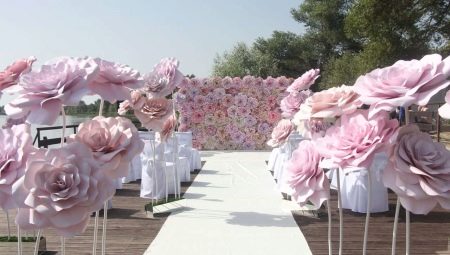If earlier artificial flowers were a sign of bad taste, now that the quality of manufactured products has improved significantly, they have become used everywhere. Beautiful and "eternal" flowers can be made with your own hands. This article will tell you how to make beautiful flowers from Isolon.
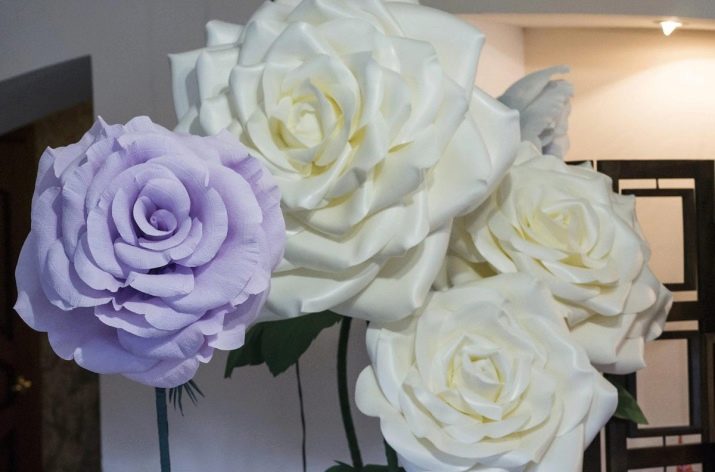
Features
It should be noted right away that isolon is usually sold in building supermarkets, another name is polyethylene foam. It is used as a coating for insulation, most often placed under a laminate. This material is sold in rolls, where the thickness of the sheets can vary from 0.2 to 100 mm. For flowers, sheets from 2 to 4 mm thick are used.
The isolon itself can be of different colors, including foil. One of the reasons for using isolon for making artificial flowers is its ability to be easily cut with scissors or a penknife.
Let's talk a little about the properties of this material. It is not subject to fire, but only melts.
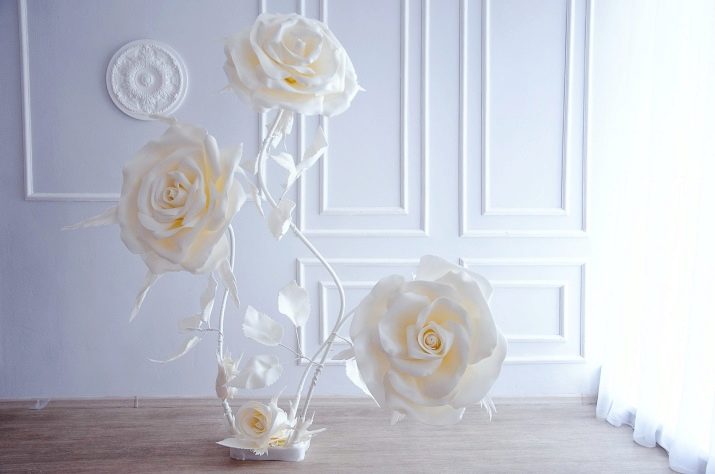
Another notable feature of Isolon is that it does not lend itself to staining with conventional dyes.
Simply put, they practically do not stay on it, it is necessary to acquire a separate type of paint.
Next, we consider other characteristics of the isolon, making it a good material for the manufacture of artificial flowers.
Isolon is a safe material that does not release various carcinogens into the air. It is included in the list of materials used in the manufacture of toys. The temperature range for its usual state is from -60 to +75 degrees Celsius.
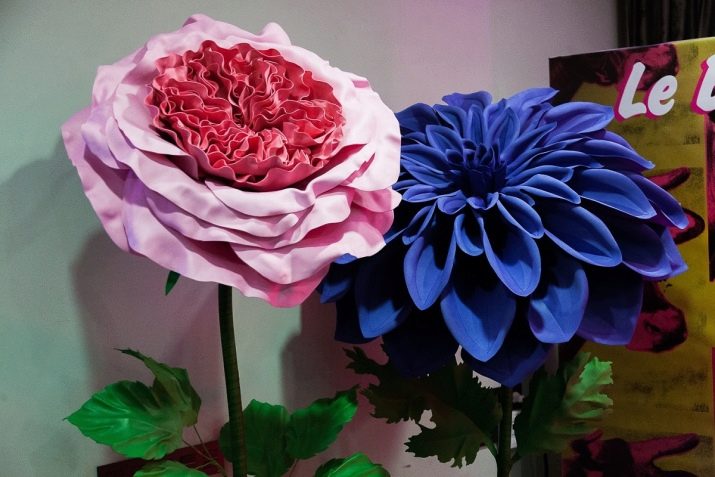
Isolon has a number of unusual properties that give crafts from it various advantages, unlike other materials.
The main advantage of isolon flowers is the ability to give any bend to the petals. This is possible due to the fact that when exposed to high temperature material, the isolon does not light up, but begins to melt, and later bends, as already mentioned. Thus, by acting slightly on the flower petals with fire, you can give them a slightly wavy look or fix any shape. You can give the petals a wave and just stretch the material. Isolon is able to withstand heavy loads when stretched, while changing its appearance.
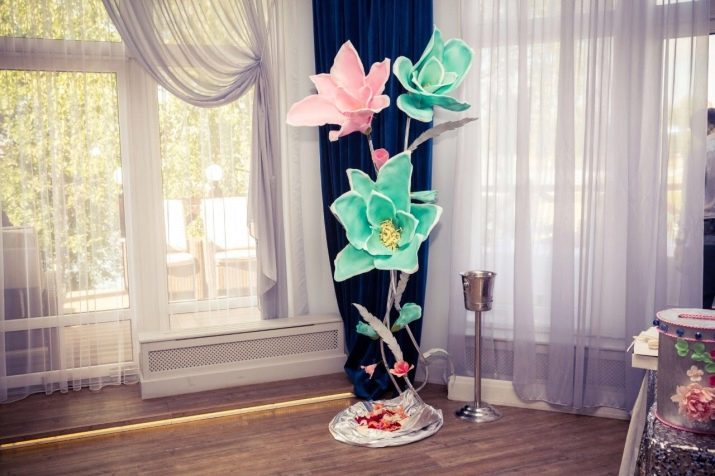
Due to the thinness of the leaves of the isolon, the flower petals look natural. They can be fastened together under the influence of high temperature. Another way to connect the petals is mechanical - using thread with a needle or other bonding materials. It must be remembered that this material “remembers” the form. For this reason, you can not mash the flowers and store them in this form. The creases will remain on the petals.
However, flowers from Isolon can be wetted - they will perfectly tolerate this. But they should not be exposed to direct sunlight. From this, their color may acquire a yellow tint. This is especially true of the white isolon.
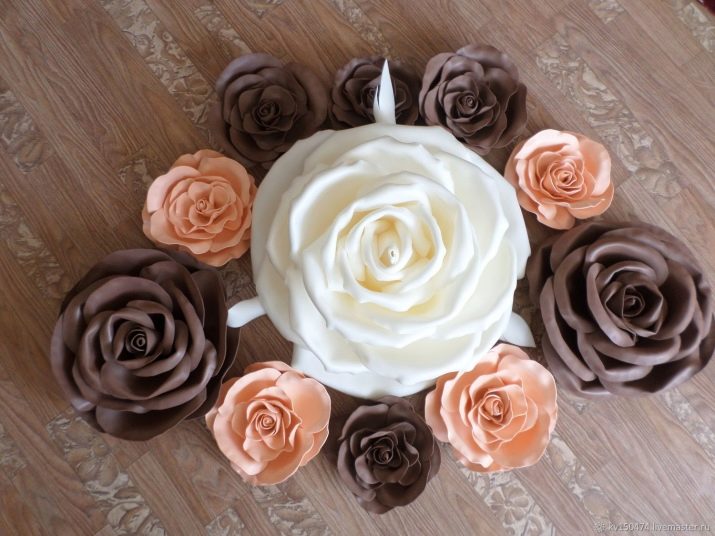
Necessary materials and tools
First of all, for making flowers, we will need a knife for cutting the material. It can be both an assembly knife and ordinary scissors.
Another thing necessary for fastening is a glue gun and a hair dryer. The latter can be taken both ordinary and construction.
Another set of necessary things is thread with a stapler.
And, the last thing we need is acrylic paints. But you can also use spray paint.
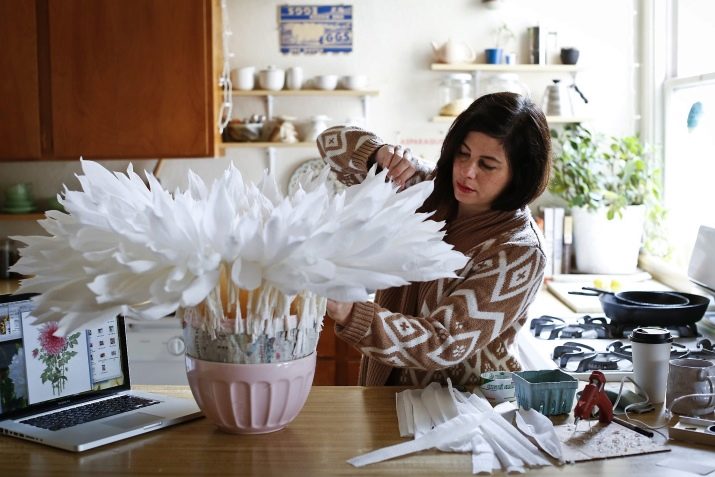
It is worth noting that in the manufacturing process a number of materials and objects may be needed, but this is optional.
In the end, everything rests on the boundaries of your imagination and your skill.
You can calculate the amount of isolon that goes into one flower yourself. To do this, you just need to add up the entire area of the cut petals. Typically, small flowers take from one to two standard store leaves of isolon. The growth crafts can take meters of material.
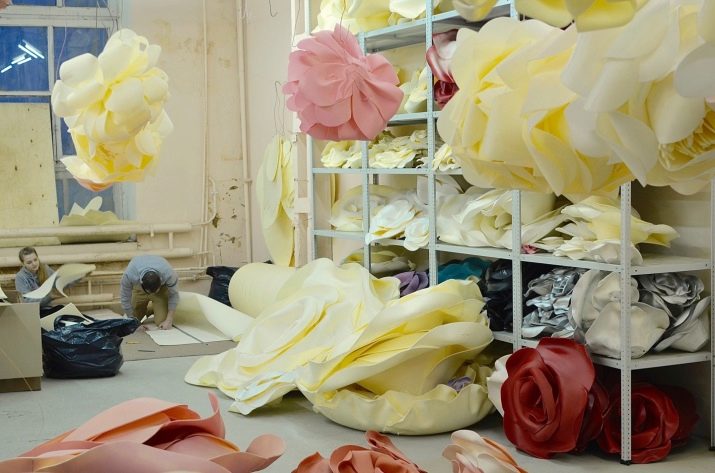
How to make?
Even a child can learn to make artificial flowers from Isolon. The following is a step-by-step instruction for making a bud with a detailed description for beginners.
- The first thing to do before you start making a flower with your own hands is to decide on the color. You are not limited in the choice of colors, but it will be best to focus on the shades of real colors.

- Another important step is choosing the size of the petals. Before you begin, you must have a clear idea of what you want to get in the end. It is worth noting that the sizes of the petals can be very different. For example, small roses can have sizes from 1 to 12 cm or even larger. If you want to make a large flower, you need to purchase an isolon, the thickness of the sheets of which will be more than 3 mm. This is due to the fact that how large flowers will keep their volume depends on the thickness of the isolon. In general, the number of petals for one flower is not limited. They can be fastened to each other as long as it seems possible.
However, flowers made from thick sheets of isolon will look rude and unpleasant. For growth flowers, the number of petal sizes should be from two to five. For example, several petals 40x40 cm in size, another 20x20 cm, 15x15 cm and so on.
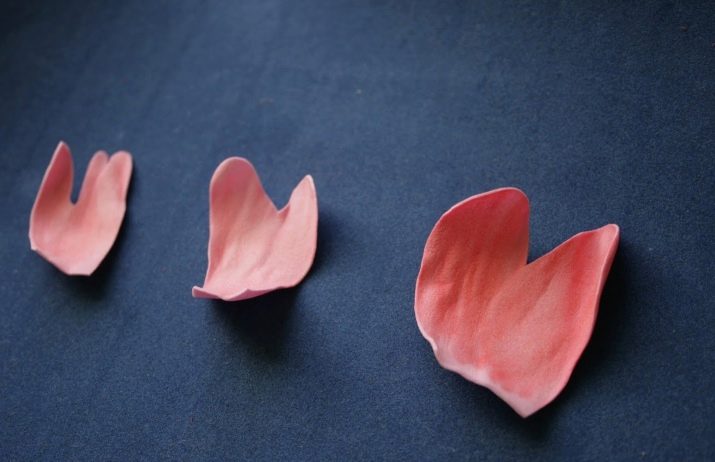
- The next step is to prepare and cut the template. Traditionally, a template can be easily cut out of paper on which diagrams were previously drawn.

- After you need to give the leaves the desired shape. You just need to slightly heat the isolon, and stretch the leaves with your fingers. But also the petals can be adjusted only on one side. In this case, as with the choice of color, it is best to focus on the model in the form of a real flowering plant.If the petals of chamomile and chrysanthemum practically do not differ from each other, then this can not be said about orchids. The manufacture of lily petals also needs to be treated more carefully.
Their petals are quite large, so their differences are quite noticeable, which should be reflected in the manufacture of artificial analogues.

- The penultimate step is to glue all the petals into a flower with hot glue. Here you also need to consider how the petals of real flowers are located. Isolon leaves should be fastened in pairs or alternately depending on the appearance of a natural flower. In general, all flowers can be divided into two groups - those whose petals are located freely relative to each other, and those whose petals are tightly adjacent to each other.
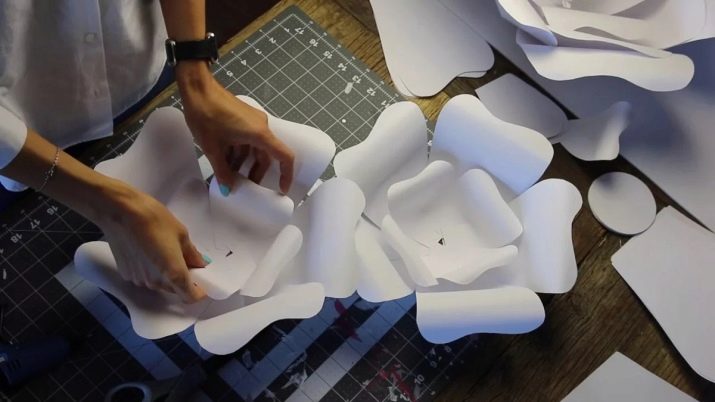
- The final, but not always necessary step is painting the flower with aerosol paints. Craftsmen can even draw streaks on the petals, which are mainly needed for roses, tulips and lilies of the valley.
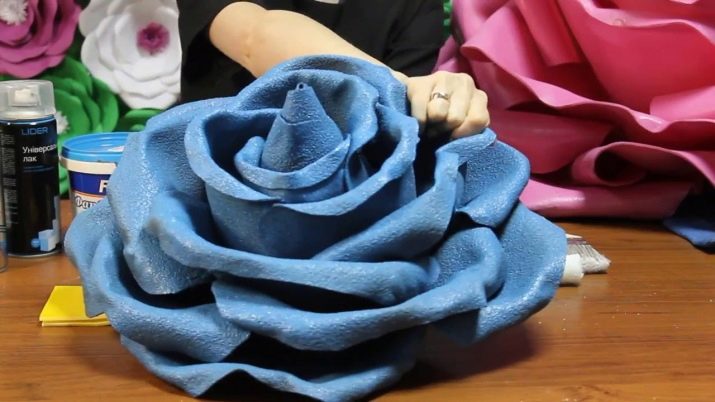
Any master classes include, in addition to instructions, a number of useful tips for creating flowers with your own hands.
Obviously, the flowers do not consist only of buds, they also have leaves, stems, buds, thorns and so on.
Stem
Sometimes it is absent, as the flower can be attached directly to the surface. If you plan to store flowers in a standing position, then in this case the stem is certainly necessary. Usually a tube is used as a stalk. The stem is used as a support for the flower. Therefore, it can be replaced with punched tape. For fastening, for example, on a panel or a wall, you can use large paper clips. Especially for this, holes are made in the panel or hooks are installed.
Another concept of wall mounting is the suspension of a horizontal or vertical base on which the workpieces are mounted.
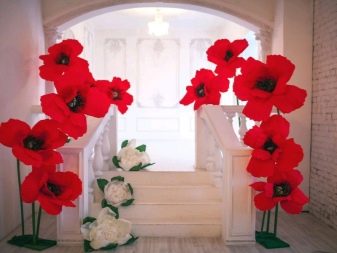

In addition to punched tape, it can be cornices, and even ordinary fabrics.
The stalk for volumetric flowers can serve as a hollow tube with a diameter of 40 mm or more. It can be both plastic, and metal, and metal-plastic.
Leaves
The leaves on the stem are attached using the same technology as the petals. First you need to cut them according to a previously prepared scheme and later bend them or make them wavy. It must be borne in mind that for growth flowers leaves are required.
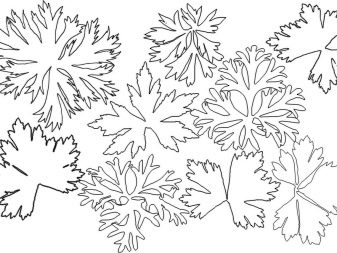

Stand
It is also necessary for one or more growth flowers. Welded coasters are considered ideal. To do this, low poles are welded onto a metal sheet with a thickness of more than 3 cm. Later, tubular stems of flowers are planted on these poles.
But there is another option for a do-it-yourself DIY stand. To do this, you need to prepare a hollow tube or several tubes, as well as a floor pot for ordinary flowers. Take one tube, install it in the pot, then pour a third of cement. When it hardens a little and fixes the position of the tube, then add more cement.
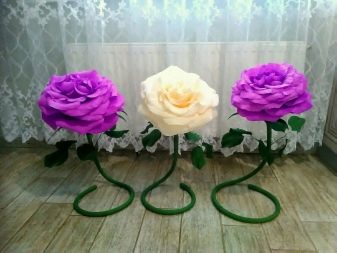
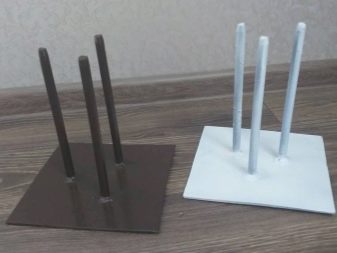
If you make a stand for a composition of flowers, then you need to do the same with a few tubes.
After all layers of cement are completely dried up, the pot is decorated with a cloth or paints. Instead of cement, gypsum can be used, and the pot can be replaced with a barrel, in rare cases even with an ordinary bucket. It must be remembered that the walls of the tank must be tight so that they do not burst while the cement dries, expanding in volume.


It is best to choose wide, hollow tubes so that you can insert flower stems inside, rather than pushing them on the outside of the tube.
Such coasters are quite massive, so they not only withstand a large weight of flowers, but practically do not roll over. By the way, such coasters can also be made from small pots.
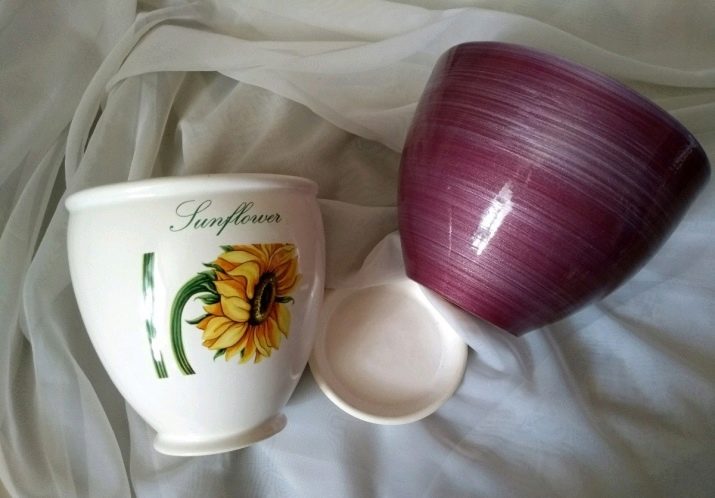
Song Options
Most often, it is huge and outdoor flowers from Isolon that are used as decor at various events. Usually the color scheme is kept in pastel colors.Celebrations also use wall panels and single flowers to complement the decor. Some stores attach large buds to the wall, thereby making thematic decorations for various holidays. Growth flowers are frequent details of the decor of celebration halls, photo studios and shop windows.

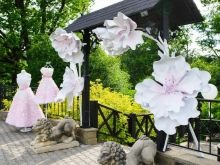

Bouquets of flowers from Isolon do not tolerate a wide variety of bright colors.
If you still want brightness, then it is best to stay on one shade, for example, red.
Such crafts are used not only for decor, you can also make a sconce from them. The best option in this case is an outdoor sconce flower in a pot. It should be borne in mind that for a homemade lamp you need to purchase only an LED lamp. It does not heat up; therefore, practically no melting of the isolon occurs. But it is best to be safe, and not too tightly stick the material to the lamp.
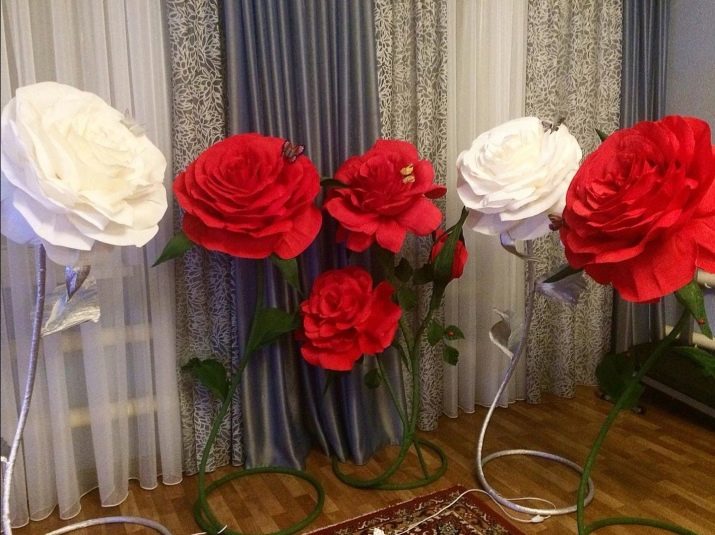
It is noticed that flowers from Isolon go well with long curtains or other plain background.
Peonies look great as desktop colors. Making a bouquet of them in a hat box, peonies can be presented as a gift. As a rule, table flowers from Isolon are used as decoration for a night lamp. This desktop sconce looks impressive, pleases the eye and fills the room with muffled light.
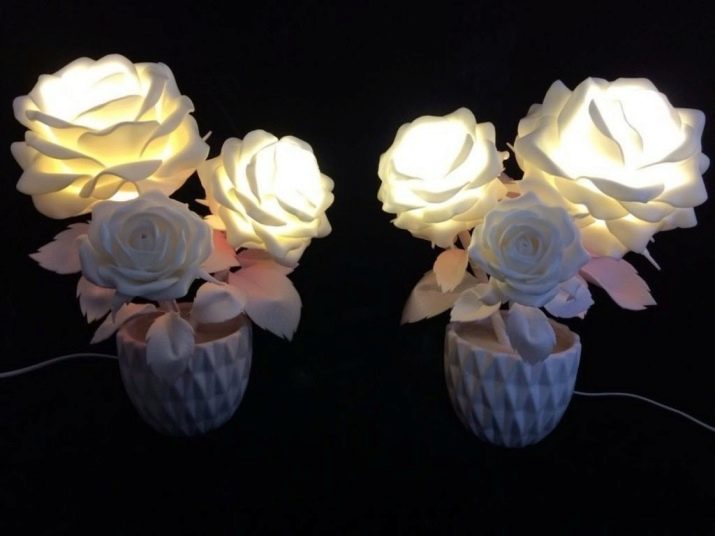
Care Tips
Obviously, the best paint falls on white. Therefore, if you plan to paint flowers, then you must initially use the white isolon. There are only three types of dyes that can be used to dye isolon.
- Rubber dye. It is characterized by durability, resistance to temperature and humidity changes, uniform structure during application. But after drying, it becomes dull, so more often varnish is also applied on top of it.
- Acrylic paint or acrylic enamel. It is also characterized by durability - it can maintain its original appearance for several years. It can only be applied with a spray gun.
- Conventional spray paint. This is the most affordable, affordable and fastest option for painting flowers from Isolon. But under mechanical action, the coating may crack and fall. Such dyes have a very uneconomical consumption of the composition. Simply put, for large-scale paints they are expensive.
- Car enamel. It lays well on the isolon and is also durable. This paint is expensive and has a high consumption.
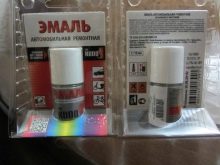
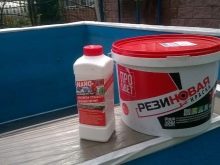
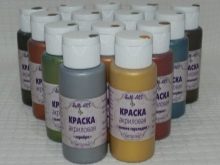
Summing up the theme with paints, it is worth noting that it will be best to paint the finished product with a spray gun. But if there is none, then it will be necessary to tint each petal with rubber paint, and later collect the bud from them.

A separate topic is the cleaning of such flowers. It is clear that they are strictly forbidden to wash. Nevertheless, it is imperative to look after flowers from the isolon, since practically no terrain is notable for clean air with no dust. It can be shaken off with a feather or bristle brush. Another way to get rid of dust is a hair dryer. It can only be used in cold air mode.
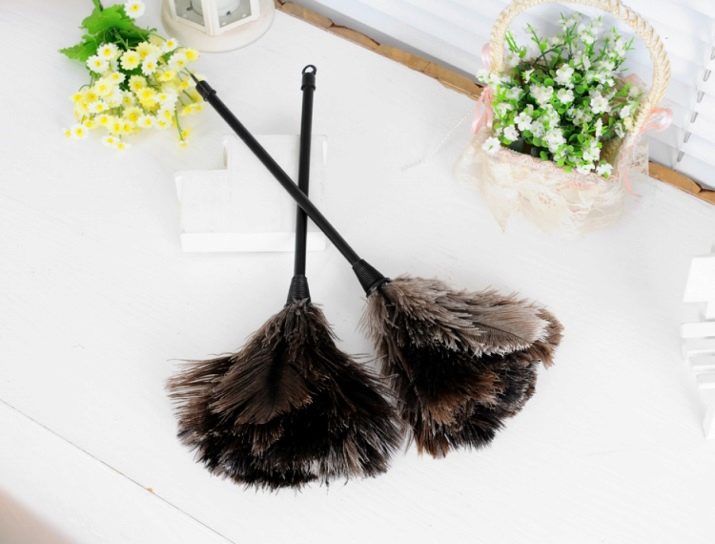
Sprayers with pressurized air can also serve as an assistant in this matter. They also blow dust or other debris.
Isolon products must be treated with an antistatic agent. If it so happened that the products were stained, then you need to carefully remove the flower from its stand, then rinse under a small stream of shower. Water should not be hot, but moderately warm.
If you saw stunningly beautiful flowers from the isolon in any room, then be sure that such a masterpiece can very well be made at home.
See how to make flowers from Isolon.
